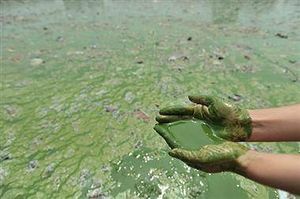Eutrophication

Eutrophication is a state in which big bodies of water such as lakes, parts of the ocean and other reservoirs have a surplus of algal growth due to excessive nutrients such as phosphorus and nitrogen. Eutrophication occurs naturally but can be severely accelerated due to human activity. This results in an excess of algae by photosynthesis, ultimately choking a body of water of oxygen, creating an anoxic environment and killing the algae and other organisms present. After the death of the algae, bacteria forms and eats it. This phenomena creates a marsh which finally turns the once body of water into a meadow or forest.[2][3]
Causes
Human activity such as fertilizer runoff from farms, industrial wastes, agricultural ponds and purposeful eutrophication have severely damaged many ecosystems. Fertilizers are the leading cause for eutrified areas because they contain all the key ingredients for prosperous growth: nitrogen, phosphorous and potassium. These three elements can be found not only in runoff from farming but in sewage and in industrial wastes. Agricultural ponds such as fisheries or algae species that are cultivated for nutritional products are often purposely eutrified to enhance the productivity. However these ponds are at severe risk of attracting invasive algae species, killing the product of interest.
Before humans had an effect on eutrophication, it occurred naturally and can be a crucial part to keeping an ecosystem healthy. It can occur due to excessive sunlight or over long periods of time with sediment deposits from erosion and weathering. Phosphorous, nitrogen and potassium are also naturally occurring, phosphorus and potassium accumulate in mineral formations and nitrogen fixed by bacteria and in some cases lightning can deposit nitrogen from the atmosphere.[3][4]
Consequences
A major issue with eutrophication is the buildup of algae and other invasive biomass that may harm a body of water and its inhabitants. For example phytoplankton is a noxious dense bloom that limits water visibility and reduces the quality of water. The limited visibility from these dense blooms reduces the amount of sunlight that penetrates the water thus killing off plants and other species that need light to thrive. This immense increase in photosynthesis causes a lack in carbon raising the pH of the water furthermore killing more species. When the plants and algae begin to die out, the decomposition drains the oxygen stores creating an anoxic environment, creating a lack of oxygen in the body of water ultimately killing the rest of the species in the area. All of these issues considered, this also causes a major threat to land species and humans, as the bacteria could penetrate our drinkable water systems and affect our agriculture. [4]
Solutions
Wastewater treatment is the best solution to solving some of the issues associated with eutrophication. By removing the major inorganic nutrients such phosphorus and nitrogen upstream, this reduces the potential for eutrophication downstream. Unfortunately nutrient control can be incredibly expensive and tough to manage, as sometimes it is unknown as to where the invasive species is originating. Algaecides have also proven to aid with the removal of algae however this does not aid with the primary problem.[3]
References
- ↑ Figure 1: S.Ghimire (2015, 12, 31). What is Eutrophication? [Online]. Available: https://www.quora.com/What-is-eutrophication
- ↑ NOAA (2008, 03, 25). Nutrient Pollution – Eutrophication [Online]. Available: http://oceanservice.noaa.gov/education/kits/estuaries/media/supp_estuar09b_eutro.html
- ↑ 3.0 3.1 3.2 S.E. Manahan, “Fundamentals of Environmental and Toxicological Chemistry,” 4th ed. Boca Raton, FL, CRC Press Taylor & Francis Group, 2013, ch. 1.3, 3.5.1, 4.7, 4.8, 5.12.
- ↑ 4.0 4.1 M.F. Chislock et al., (2013 Nature Education). Eutrophication is a leading cause of impairment of many freshwater and coastal marine ecosystems in the world. Why should we worry about eutrophication and how is this problem managed? [Online]. Available: http://www.nature.com/scitable/knowledge/library/eutrophication-causes-consequences-and-controls-in-aquatic-102364466

